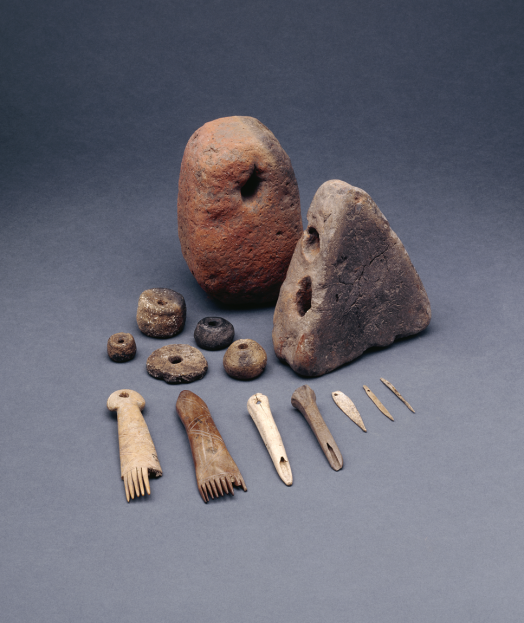
Evidence for cloth making
The clothes that people wore in the Iron Age generally do not survive. They were made of soft organic materials such as wool, linen and animal skins that have rotted in the ground. Every now and then archaeologists find pieces of clothing surviving in waterlogged conditions, or evidence of cloth impressions on baked clay or in rust from long-buried iron objects, for example, the examples from Burton Flemming in For the classroom.
What have survived in great numbers are the objects made of bone, stone, antler or baked clay that were used to make the clothing. Thread was spun using a drop spindle weighted at one end by a stone or clay whorl to provide tension and momentum. Spindle whorls are usually circular with a hole in the middle. Loom weights, generally of baked clay with a hole poked through before firing, could be triangular or rectangular. Weaving swords, combs and needles were made from leftover animal bone or antler. From this evidence we can deduce that Iron Age people spun thread and used upright warp-weighted looms to weave cloth.
Steps to making clothes
Wool was sheared from sheep, cleaned, carded and then spun using spindles. In Britain, Iron Age cloth was said to be of a chequered pattern of at least two colours so the wool was probably dyed after it was made into yarn. The fibres inside the flax plant were retrieved by retting (rotting) the stems of the plant in water-filled pits and then it was spun in a similar way to wool.
In the Iron Age most weaving seems to have been done on upright looms, with loom weights weighing down the warp (vertical) threads. Images from the Late Bronze Age in Italy show the looms had bars, which could be moved to separate the warp threads so that it was easier to pass the weft (horizontal) thread through. Weaving swords and combs were used to beat the weft threads to make the weave very close.
The resulting rectangle of fabric was then probably sewn together to make a tube-like garment. An edging band may have been made separately and sewn on to the edge of the cloth. The garment was fastened with brooches or cloth tabs at the shoulders and possibly gathered at the waist. Both men’s tunics and women’s dresses were probably made and worn this way.
What did people look like?
As well as the tools to make the objects, we have a few accounts from Greek and Roman writers that give some idea about the rest of an Iron Age Briton’s appearance. Julius Caesar, for example, wrote that British men had long hair and moustaches and that they dyed their skin blue for battle using a plant dye called woad. There are also some representations of heads in jewellery, coins and other items which show male heads with moustaches. These all date to the late Iron Age, though, and people may have looked different in the early Iron Age.
More information
Introduction to clothing
A short article on clothing from the British Museum website.
http://www.britishmuseum.org/explore/highlights/articles/c/clothing_in_iron_age_britain.aspx
Objects of Iron Age Britain
Click through ten objects from Iron Age Britain on the British Museum website.
http://www.britishmuseum.org/explore/highlights/articles/b/britain_in_the_iron_age.aspx
Life in the Iron Age
Useful information from BBC History including a diagram of an upright loom.
http://www.bbc.co.uk/history/ancient/british_prehistory/ironage_intro_01.shtml
Drop-spindle
A video from the National Trust for Scotland showing how a drop-spindle works.
http://youtu.be/bKAJTKvl0nE
Upright loom
A silent 1947 film from Norway giving a very good idea of the laborious process of setting up and weaving on a traditional upright loom – finish at 6:20.
https://www.youtube.com/watch?v=6PD-FASC6ZQ&list=PLYJPyz3C0YUmPh49uIN5LRCF6bps5qzdd&index=2
More information
-
Introduction to clothing
A short article on clothing from the British Museum website.
Source: britishmuseum.org
-
Objects of Iron Age Britain
Click through ten objects from Iron Age Britain on the British Museum website.
Source: britishmuseum.org
-
Life in the Iron Age
Useful information from BBC History including a diagram of an upright loom.
Source: bbc.co.uk
-
Drop-spindle
A video from the National Trust for Scotland showing how a drop-spindle works.
Source: nts.org.uk
-
Upright loom
A silent 1947 film from Norway giving a very good idea of the laborious process of setting up and weaving on a traditional upright loom – finish at 6:20.
Source: norskfolkemuseum.no


